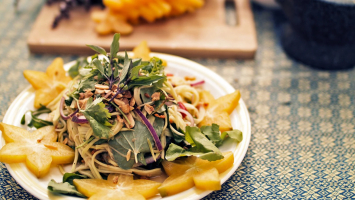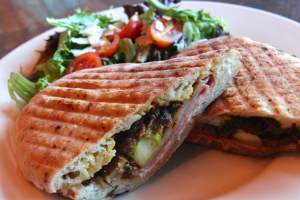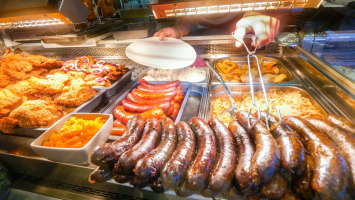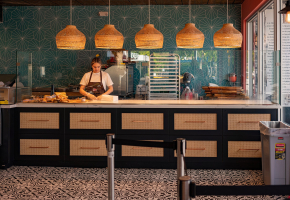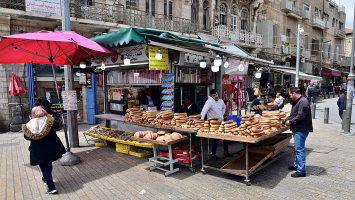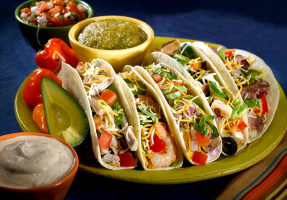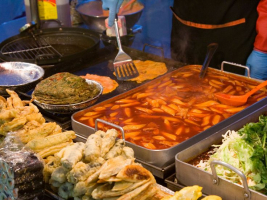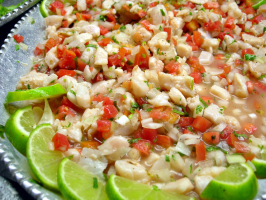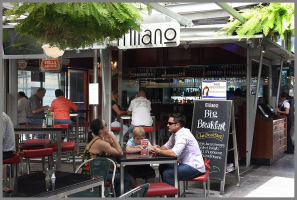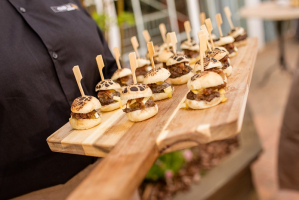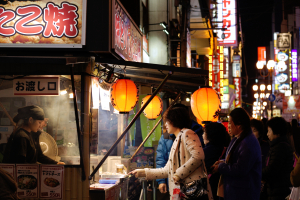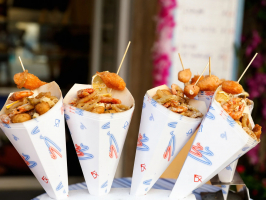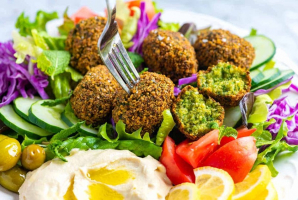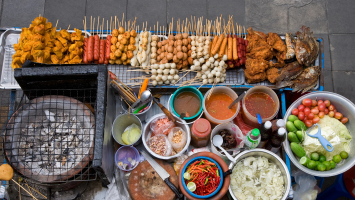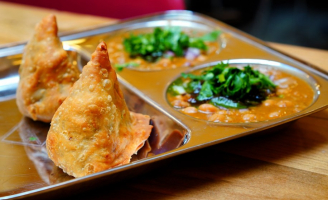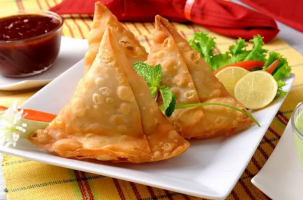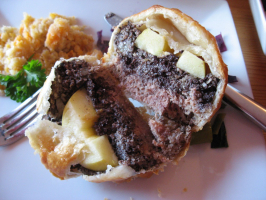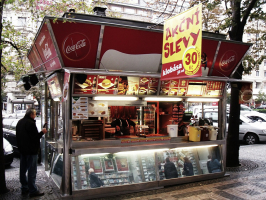Top 10 Best Traditional Food in Syria
Syria is famous for many things, one of which is the tasty and distinctive cuisine. For travelers who first set foot in this wonderful country, it can be quite ... read more...challenging to decide what to eat here. Have no worry, as this Toplist article would lift off some pressure for you.
-
Dolma is a common Syrian dish that originated from Azerbaijan. Dolma, in Azerbaijani, means “full” or “stuffed”. The traditional way of creating a Dolma is very straightforward. You just need to combine rice, sliced greens, salt and black pepper in a big dish. Preferably, the mix should have coarsely diced and seasoned (or minced) meat.
After putting everything together, the next step for you is to roll the combination in salt-water pickle vine leaves (without the stock) and fry them. In some cases, some people add lemon juice and chicken stock to the Dolma before cooking. This tactic is to improve juiciness. Furthermore, filled vegetables, fish, or even fruits can be put into a Dolma as well.
Dolma was traditionally made by a woman to her spouse prior to their wedding. Dolma has always been seen as a dish associated with family bonding and togetherness. As a result, it is prepared for a variety of special events. The rice-only form of the Dolma is named Yalanci Dolma, which translates to "liars dolma" due to its absence of meat.
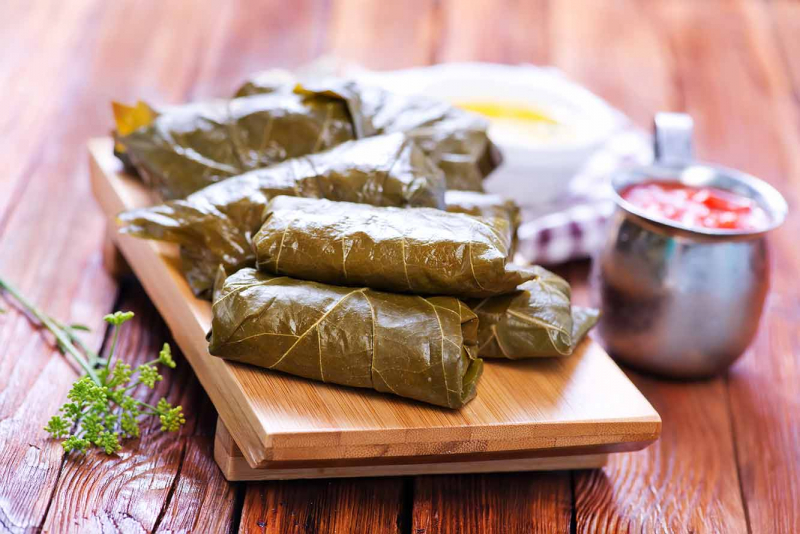
Source: Veggie Fest Chicago 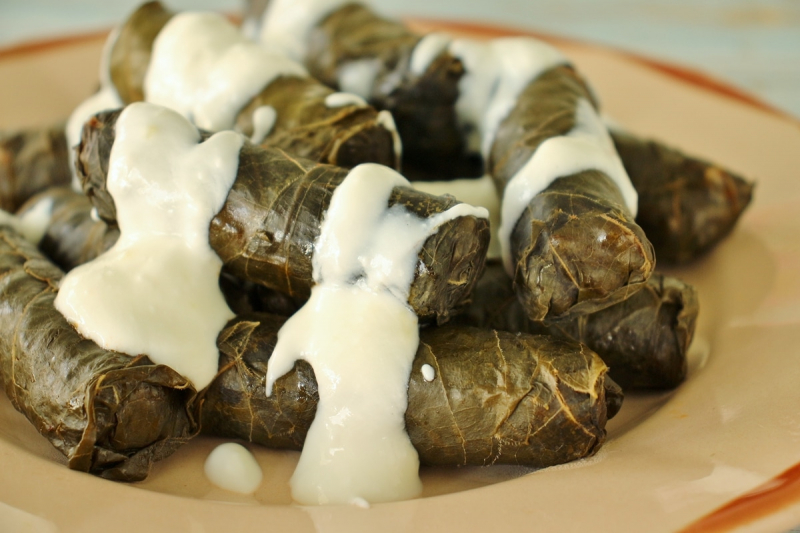
Source: Mission Food Adventure -
Baklava is a traditional Syrian dish, prepared with almonds and icing sugar wrapped in filo. Filo is a term that refers to thin sheets of unraised dough, which are used in a variety of sweets. Baklava's original recipe is believed to have originated during the Ottoman Turkish era.
A traditional Syrian Baklava recipe calls for the preparation of syrup, with a splash of lime juice. After chilling down, the syrup is combined with finely chopped walnuts. Cooking time for a Baklava tray is around 35-40 minutes. Once the flaky layers have become golden brown, the Baklava is topped with more sugar syrup, and garnished with walnuts and other beans.
Although this traditional Syrian dessert is irresistible and may be consumed in a matter of hours, people prefer to keep it for long term usage. Baklava is often kept in a sealed jar at room temperature for up to seven days.
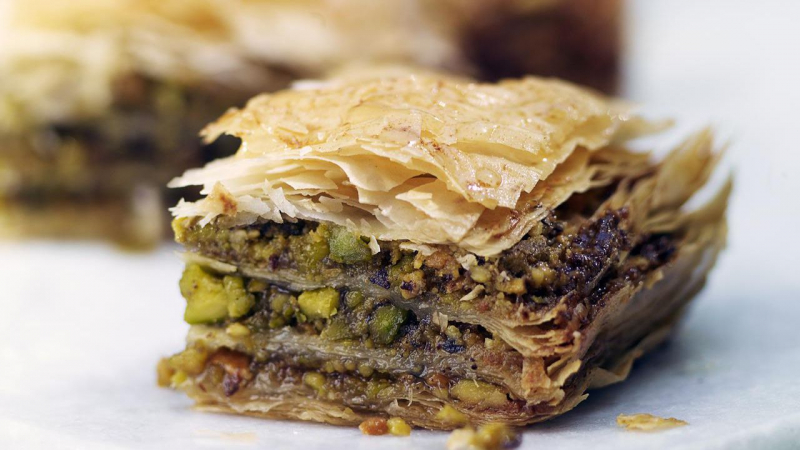
Source: The Spruce Eats 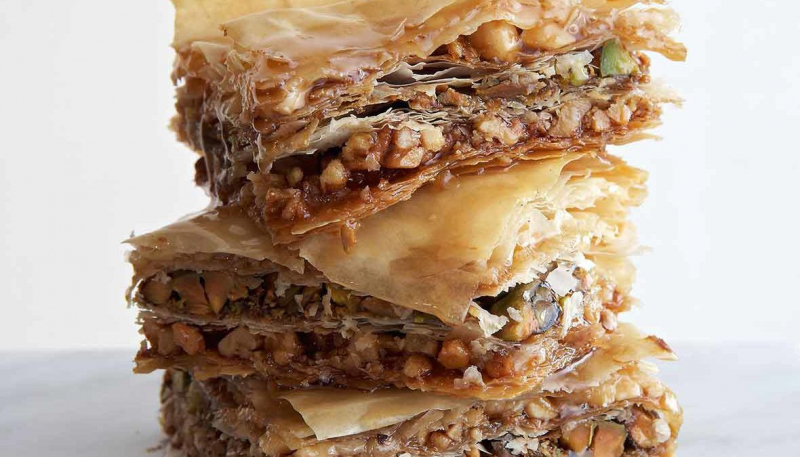
Source: Leite's Culinaria -
Kibbeh bil Sanieh, or "Kibbeh in the pan”, is a baked variant of Kibbeh. Kibbeh Bil Sanieh is indeed the country's national dish, and is widely regarded as one of the most popular traditional Syrian meals prepared in every family.
Three layers of beef and onions make up the Kibbeh Bil Sanieh. Kibbeh is cooked with minced beef, bulgar or bulgur (a kind of par-boiled wheat grain that resembles semolina), mixed spices, salt, pepper, and onion paste. The central layer is composed of finely chopped beef, cooked with onions, toasted pine nuts, and seasonings. Between different layers of Kibbeh, the cooked meat is neatly placed and roasted for 40-50 minutes. In most cases, the Kibbeh Bil Sanieh is eaten with cake-like slices of natural yogurt.
The Kibbeh Bil Sanieh is regarded as a main course. The Kibbeh Balls, on the other hand, are considered an appetizer or "mezze." Although the adorable football-shaped dishes give you a lot of fun to eat and are a lovely welcome meal for visitors, it is quite time-consuming to make them.
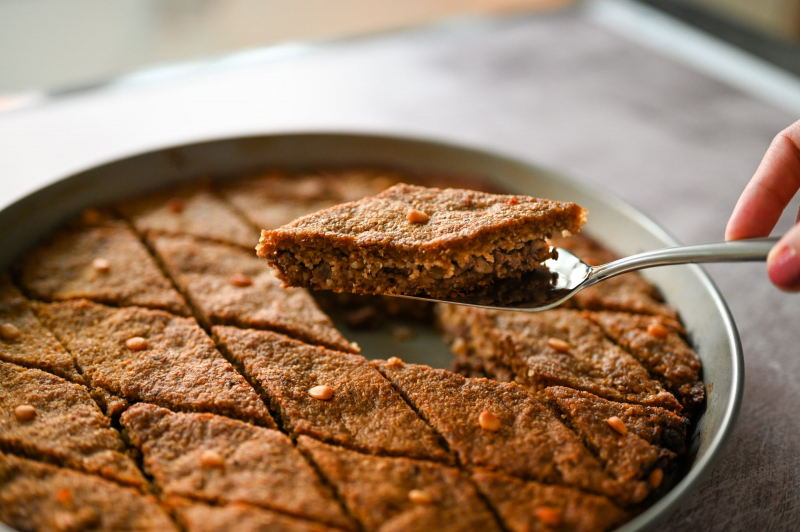
Source: Simply Lebanese 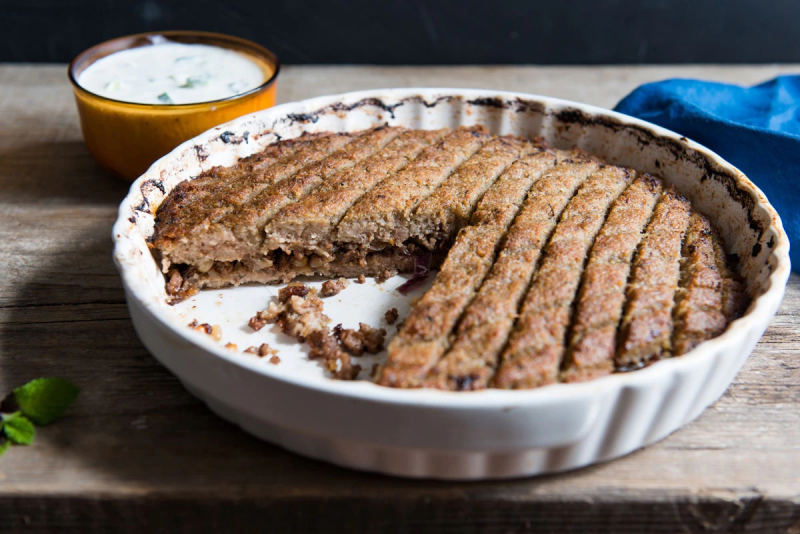
Source: SBS -
This Syrian cuisine is known for its abundance of stuffed and vine leaves. Yabraq is a kind of filled vine leaf comparable to a Dolma, but with a slightly different cooking procedure.
Yabraq is created from frozen vine leaves that have been soaked in boiling water to prepare for rolling. The filling is created with minced lamb flesh, 'liyeh' (lamb or sheep tail fat), salt, and freshly cooked Egyptian rice. To prepare Yabraq, you only need to use medium and tiny grape leaves, which results in a cuisine that resembles cigar rolls. The beef filling is securely wrapped in grape vines, and then cooked for two hours over low heat with lime juice, green onions, water, and salt. The loaded leaves are packed snugly into the cooking pot.
Last but not least, a heavy item should be put over the cover for the duration of the cooking process. This allows the lime juice and garlic taste to thoroughly permeate the grape leaves and meat-rice mixture. To add a finishing touch, you can serve Yabraq with filtered cooking water, yogurt, meat, and hummus (Arabic flatbread).
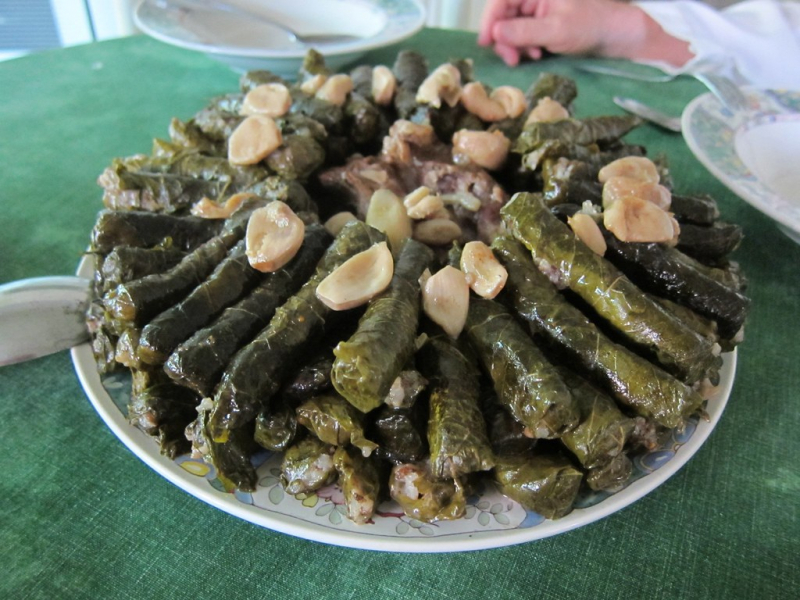
Source: Flickr 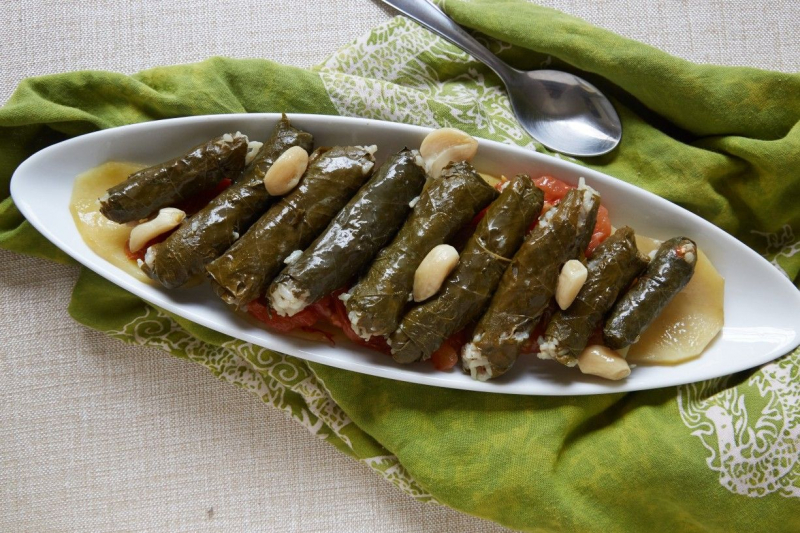
Source: Pinterest -
Kebab Halabi is a famous grilled beef dish in Syria. It's made by grilling kebabs on sticks and serving them over Laban (strained yogurt) and Syrian marinara sauce. Apart from Syria, this dish is common in a number of other nations. As a result, the recipe may differ per nation. However, the fundamental elements like coriander, cumin, cardamom, nutmeg, cloves, cinnamon, and black pepper remain the same.
Kebab Halabi is produced by combining chilled minced beef or lamb with nuts, along with a seven spice blend, onions, salts, and other vegetables. This mixture is then skewered and roasted over an open fire. To make the Syrian tomato sauce, you need to mix garlic, tomatoes, and coarsely diced onion in cooking oil until they turn saucy. This sauce is often served over grilled meat. On special occasions, you can also eat it with minted Laban prepared with strained milk, fresh mint, and cumin powder.
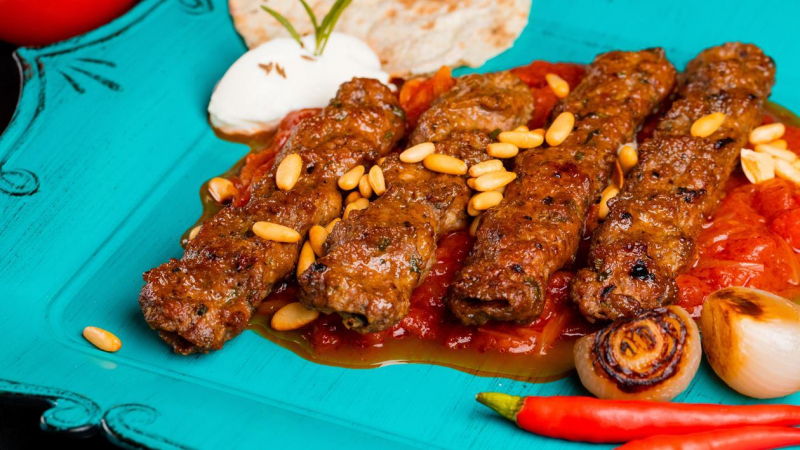
Source: Arabic Food Recipes 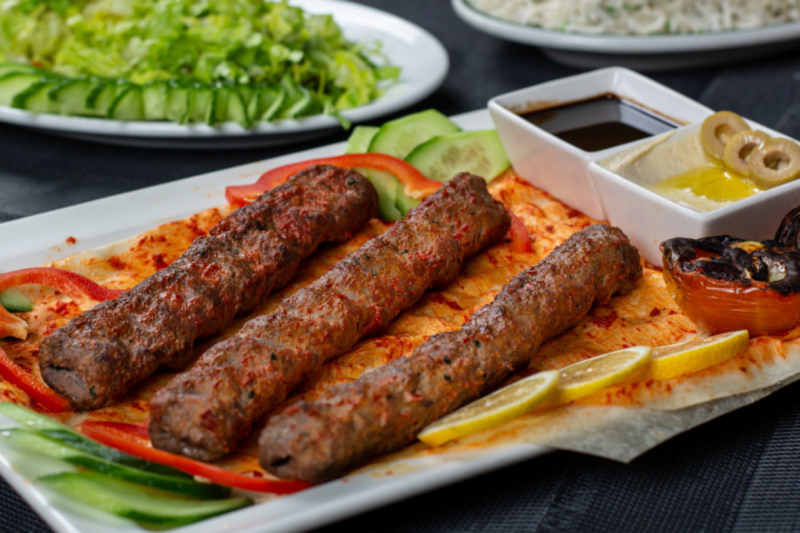
Source: Al Aktham Restaurant -
Basbousa is an Egyptian-inspired delicious, syrup-soaked vermicelli cake, which is also popular in other countries. The semolina batter is cooked on a sheet pan, flavored with citrus flower water, rose water, or simple syrup, then chopped into diamond (lozenge) or square forms. This delicious dish is found across most of the ancient Ottoman Empire's territory, and especially in Syria.
Food has a significant role in Syrian culture, both as tradition and as a source of hospitality. That is why Basbousa has been Syrians’ favorite dessert for decades. It's a classic Syrian delicacy that is moist, sticky, sweet, and incredibly delectable.
In Syria, Basbousa is prepared with almonds, raw coconut, self-rising wheat, plain yogurt, and, of course, caster sugar. All of these ingredients are combined with butter and baked for 35-40 minutes at 350 degrees Fahrenheit. When the cake is still warm, a sugar syrup mixed with granulated sugar, lemons and rose/orange floral water is drizzled over it. Not only does the sugar syrup sweeten the cake, but it also gives the overall dish some moisture and a sticky feel.
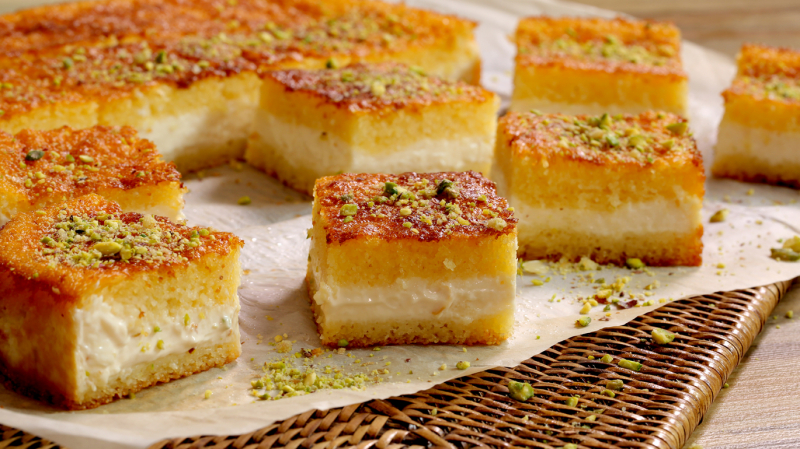
Source: Lurpak 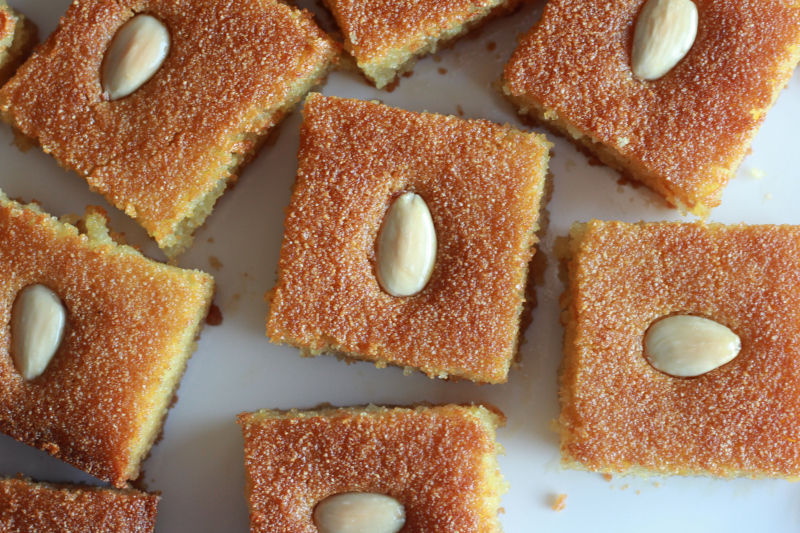
Source: Sheba Yemeni Food -
On the Middle East dinner table, Fattoush Salad is a famous staple. In general, we can say it is a basic chopped salad with a lime vinaigrette dressing. Regarding its origins, Fattoush is a Lebanese meal, and the name derives from the Arabic word for flatbread, 'fattat.' As croutons, one may use homemade pita chips.
In Syria, a Fattoush is essentially a pita bread salad with vegetables, greens, and garnish. Pita bread is combined with diced tomatoes, green peppers, radishes, onions, herbs, and mint leaves to make the salad. This bread and vegetable combination is topped with a garnish, made from sumac, pepper, salt, oil, olive, lime and lemon. Fattoush has a sweet and sour flavor profile, and the sumac is in charge of enhancing the dish's unique flavor.
As the Middle East and Syria are obsessed with fresh-from-the-oven pita, leftover pieces do not go to waste! Pita leftovers can also be used in a variety of inventive ways.
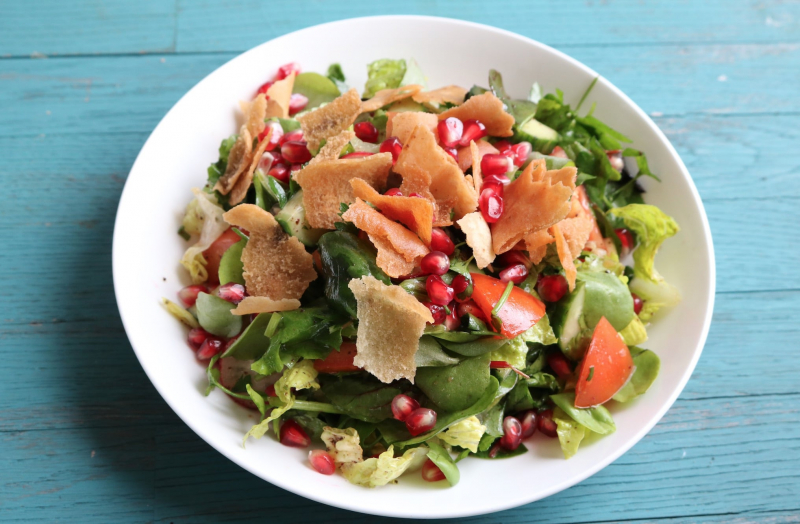
Source: Zaatar and Zaytoun 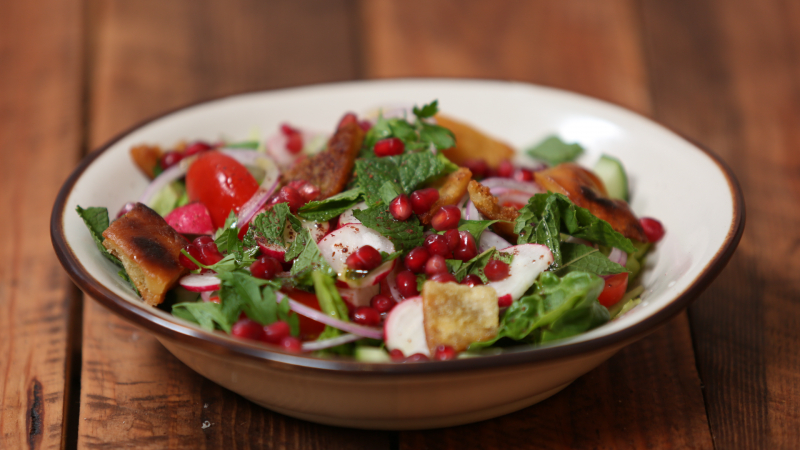
Source: Tastemade UK -
The next item on the list is none other than Samak Harra. Samak Harra is a baked fish sandwich. It is prepared with a spicy sesame sauce, as well as additional spices and seasonings. This delicious dish may be served either as a sandwich or decorated plates. If you often have guests around, Samak Harra would make such a wonderful meal.
All in all, Samak Harra is a Lebanese meal that is very easy to make. To prepare the meal, you need to roast cleaned salmon with a spicy tomato sauce garnish. Garlic, shallots, pepper, vinegar, and tomatoes are important ingredients for the dish as well. Distribute a liberal amount of the salsa over the salmon and its slices. Then, cover it with olive oil, and cook for about more than 1 hour - or until you see that the salmon is thoroughly cooked in the salsa, and the oil leaks out into the pan.
What you have as the final result is a grilled fish that is simply delectable. It would melt in your mouth, leaving you eager and hungry for more.
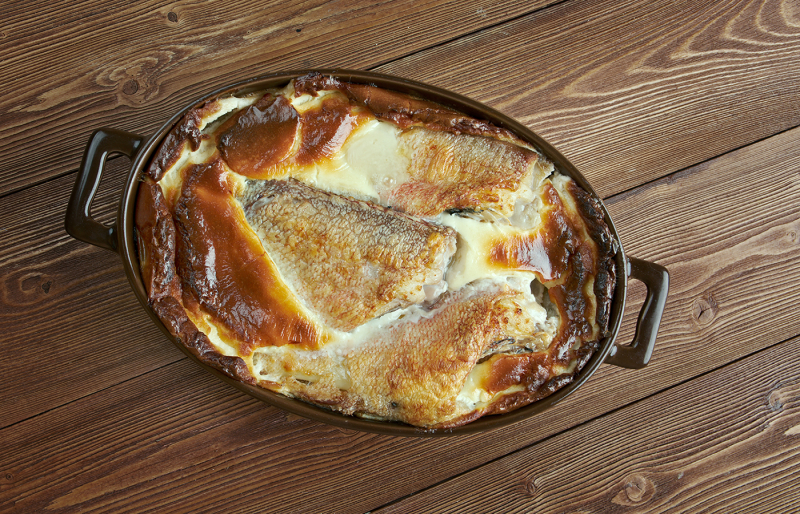
Source: World Food Atlas 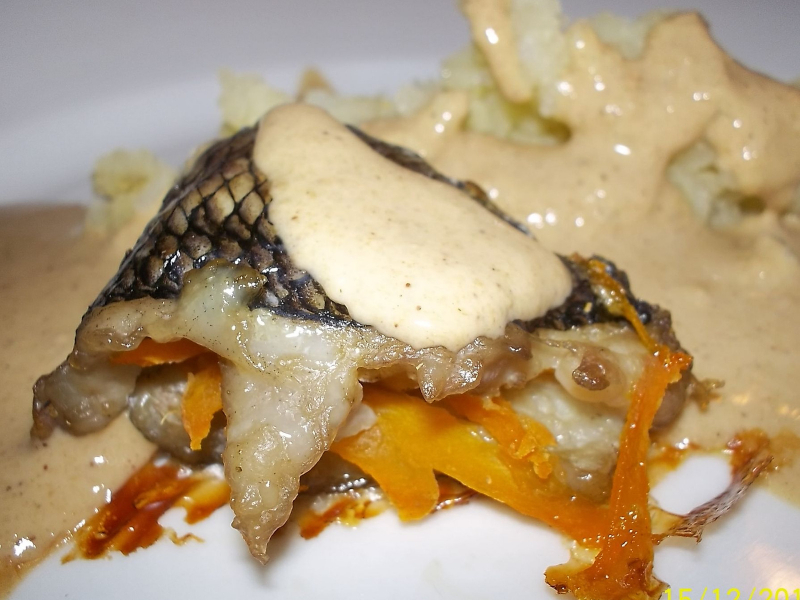
Source: Coolinarika -
Ful medames is one of the most famous stews in the world. Hence, it lands on number 9 in this list. Ful medames is made with cooked fava beans, cumin, and olive oil. Sometimes, you can spice up the traditional recipe a little by adding chile pepper, lemon juice, onion, garlic, or chopped parsley. In most cases, ful medames are served in a big metal jug.
This dish is so popular that it is even regarded as a national treasure in Egypt. Northern towns such as Gizah and Cairo are places where its popularity level is unmatched.. Ful medames are also common in Arab, Middle Eastern, and North African cuisines.
Since this list is about Syrian food, you can guess that Ful medames also garners lots of love in Syria as well. To be more precise, Ful medames is a popular morning meal in Syria, served with warm pita bread. Fava beans, freshly sliced tomatoes, and parsley are used in this recipe - along with a liberal drizzle of Tahini, olive oil, and lemon juice.
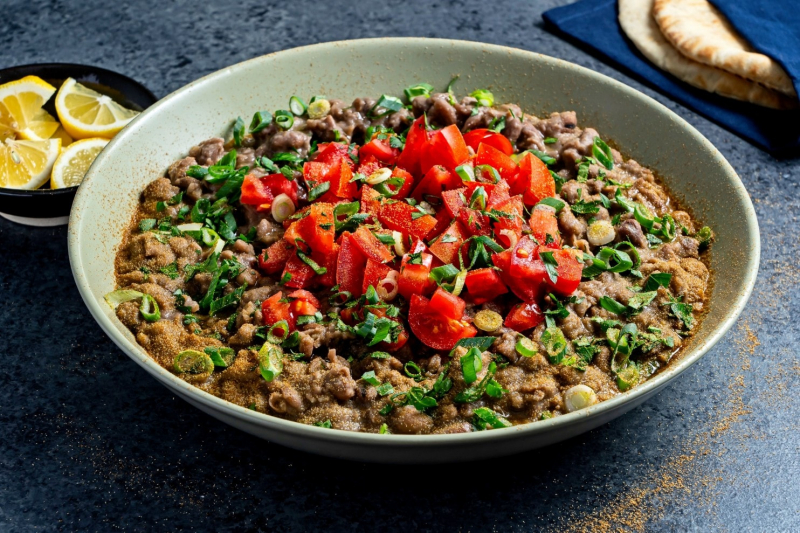
Source: The Washington Post 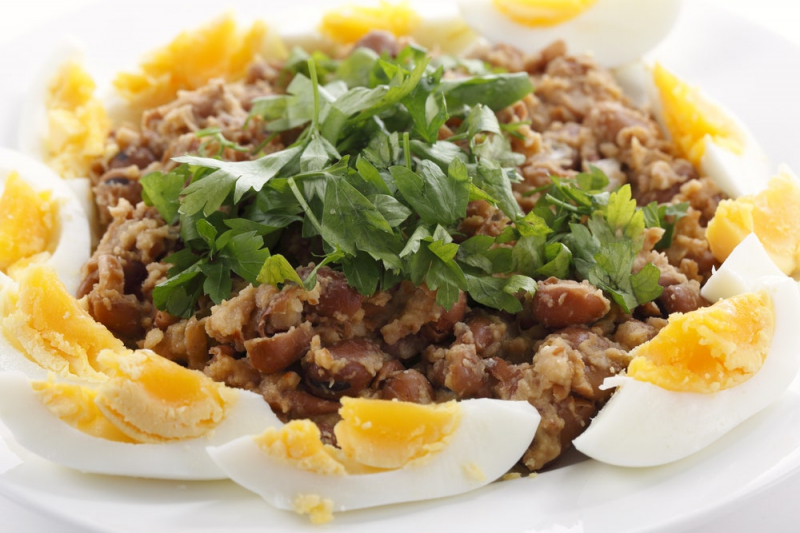
Source: Epicurious -
Muhammara (sometimes spelled as mhammara) is a spicy and juicy dip. It is meticulously prepared with lots of ingredients. The recipe may vary in each country, but the main elements are breadcrumbs, pomegranate molasses, red bell peppers, and walnuts.
Regarding its origins, some people associate Muhammara with Aleppo. However, others claim that its first arrival was in Turkey, particularly in the southeastern districts. At that time, due to the influence of Syrian culture, Arab foods had become more prevalent in these areas.
Muhammara is often eaten as an appetizer. It is a small - yet important - part of a typical mezze plate. To create this wonderful dip, you need to prepare some roasted bell peppers and hazelnuts. These spices would complement the hummus well. And while the peppers provide heat, the pomegranate molasses imparts a tart flavor to the dip. All in all, this flavorful dip is a must-try in Syria!
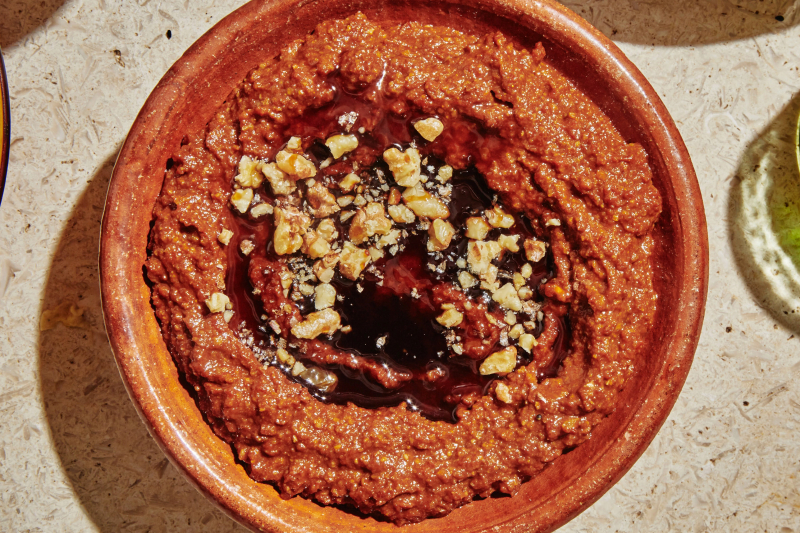
Source: Bon Appetit 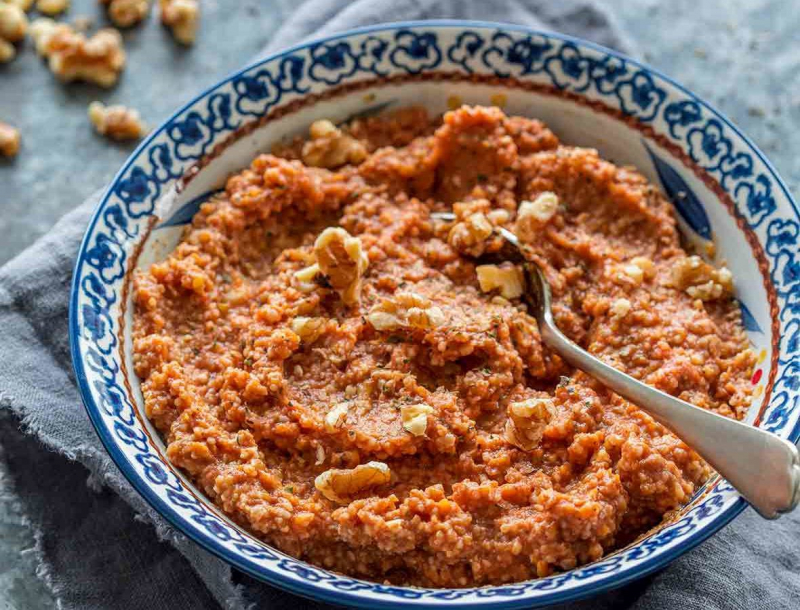
Source: Leite's Culinaria












